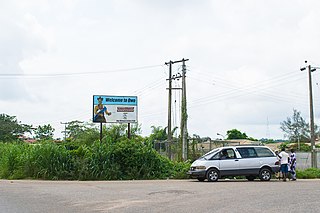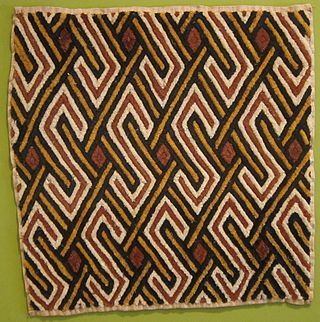Related Research Articles

Owo is a local government area in Ondo state, Nigeria.Between 1400 and 1600 CE, it was the capital of a Yoruba city-state. The local government area has a population of 222,262 based on 2006 population census.

Chief Nike Davies-Okundaye, also known as Nike Okundaye, Nike Twins Seven Seven and Nike Olaniyi, is a Nigerian Yoruba and adire textile designer. She is best known as an artist for her cloth work and embroidery pieces.

African textiles are textiles from various locations across the African continent. Across Africa, there are many distinctive styles, techniques, dyeing methods, and decorative and functional purposes. These textiles hold cultural significance and also have significance as historical documents of African design.

Twins Seven Seven, born Omoba Taiwo Olaniyi Oyewale-Toyeje Oyelale Osuntoki was a Nigerian painter, sculptor and musician. He was an itinerant singer and dancer before he began his career as an artist, first attending in 1964 an Mbari Mbayo workshop conducted by Ulli Beier and Georgina Beier in Osogbo. Twins Seven Seven went on to become one of the best known artists of the Osogbo School.
Oba Sir Olateru Olagbegi II, was the King (Olowo) of Owo, an ancient city which was once the capital of an Eastern Yoruba city state in Nigeria.

Aso oke fabric, is a hand-woven cloth that originated from the ijebu people of western Nigeria. Usually woven by men, the fabric is used to make men's gowns, called agbada and hats, called fila, as well as Yoruba women's wrappers called Iro and a Yoruba women's blouse called Buba and a gown called Komole, as well as a head tie, called gele and so on.

The Yoruba of West Africa are responsible for a distinct artistic tradition in Africa, a tradition that remains vital and influential today.

Akwete cloth is a hand woven textile produced in Igboland for which the town of Akwete, also known as Ndoki, both which the cloth was named after in Abia state, Nigeria is famous. Alternative names include "Aruru" meaning "something woven", "Mkpuru Akwete" and "Akwete fabric". This traditional Igbo weaving processes sisal, hemp, raffia, cotton or other fibres into finished products. While the coarse raffia materials are used by masquerades and in the past as headgear for warriors among other uses, the hemp material was used to weave towels, ropes and handbags. The more comfortable and colorful spun cotton is used to weave cloth for everyday wearing. Akwete cloths contain many motifs. Today, women continue to produce Akwete cloth for a wide, global market.
The Igogo festival is a Yoruba festival held in Owo, Nigeria. It is held annually in September to honor Queen Oronsen, a mythical wife of Rerengejen. During the festival, the incumbent Olowo of Owo, Oba Ajibade Gbadegesin Ogunoye III, and high chiefs of Owo Kingdom dress like women with coral beads, beaded gowns and plaited hair. The wearing of headgears and caps as well as the beating of drums and firing of guns are forbidden during the festival.
Olowo Elewuokun was a traditional ruler of Owo Kingdom, Ondo state, south western Nigeria. He succeeded his brother, Olowo Ajaka and was succeeded by his son, Olowo Aragunwaye.
Olowo Ajaka was a traditional ruler of Owo Kingdom, Ondo state, southwestern Nigeria. He succeeded his father, Olowo Ajagbusi Ekun.
Ajagbusi Ekun was a traditional ruler of Owo Kingdom, Ondo state, southwestern Nigeria. He succeeded Olowo Ojugbelu Arere, the first Olowo of Owo.
Olagbegi Atanneye I was a paramount ruler of Owo Kingdom, Ondo state, southwestern Nigeria who reigned between 1913 and 1938. He was the brother of Olowo Ajike Ogunoye and son of Olowo Olagbegi Atanneye II
Olagbegi Atanneye II was a paramount ruler of Owo Kingdom, Ondo state, southwestern Nigeria and the father of Olagbegi Atanneye I and Olowo Ajike Ogunoye.
Ajike Ogunoye was a paramount ruler of Owo Kingdom, Ondo state, southwestern Nigeria who reigned between 1938 and 1941. He was the son of Olagbegi Atanneye I and immediate brother of Olowo Ajaka.
Olagbegi Atanneye I was a paramount ruler of Owo Kingdom, Ondo state, southwestern Nigeria who reigned between 1913 and 1938. He was the brother of Olowo Ajike Ogunoye and son of Olowo Olagbegi Atanneye II

The Ekiti people are one of the largest historical subgroups of the larger Yoruba people of West Africa, located in Nigeria. They are classified as a Central Yoruba group, alongside the Ijesha, Igbomina, Yagba and Ifes. Ekiti State is populated exclusively by Ekiti people; however, it is but a segment of the historic territorial domain of Ekiti-speaking groups, which historically included towns, in Ondo State such as Akure, Ilara-Mokin, Ijare, and Igbara-oke. Ogbagi, Irun, Ese, Oyin, Igasi, Afin and Eriti in the Akoko region, as well as some towns in Kwara State, are also culturally Ekiti, although belong in other states today.

Rowland O. Abiodun, b. 1941, is a Nigerian-American professor and author best known for his contributions to the field of African Art Studies, especially Yoruba Art. He is currently the John C. Newton Professor of Art, the History of Art, and Black Studies at Amherst College, Amherst, Massachusetts.

Yoruba clothing is the traditional clothing worn by people of the Yoruba ethnic group in parts of Nigeria, Benin and Togo in a region called Yorubaland. The clothing reflects the rich culture, history and aesthetic preferences of the Yoruba people.
Aso Olona is a traditional Yoruba textile known for its intricate geometric patterns and cultural significance, particularly among the Ijebu subgroup. The term "Aso Olona" translates to "cloth with patterns" in the Yoruba language. Aso Olona is an handwoven fabrics that can come with motifs like the chameleon.
References
- ↑ Onibode, Babatunde; Poynor, Robin. "The Cloth That Eats Money: Ṣeghoṣen as a Symbol of Prestige". African Arts. 56 (3): 20. ISSN 0001-9933.
- ↑ "The BEST Things to do in Ondo, A GUIDE | ZeeGoes". www.zeegoes.com. 2023-01-10. Retrieved 2024-06-22.
- ↑ Imoniche, Eboreime James (2018-12-06). "Seghosen in continuity and change: The pride of Owo kingdom in Yoruba land, Nigeria". International Journal of Advance Research, Ideas and Innovations in Technology. 4 (6): 534–536. ISSN 2454-132X.
- ↑ Onibode, Babatunde; Poynor, Robin (2023-09-01). "The Cloth That Eats Money: Ṣeghoṣen as a Symbol of Prestige". African Arts. 56 (3): 20–33. doi:10.1162/afar_a_00718. ISSN 0001-9933.
- ↑ Onibode, Babatunde; Poynor, Robin. "The Cloth That Eats Money: Ṣeghoṣen as a Symbol of Prestige". African Arts. 56 (3): 20. ISSN 0001-9933.